Current State of Robotics in Hand Rehabilitation after Stroke: A Systematic Review
Abstract
1. Introduction
2. Materials and Methods
2.1. The Development of Hand Rehabilitation Robot
2.1.1. The Exoskeleton Hand Rehabilitation Robot
2.1.2. The End-Effector Hand Rehabilitation Robot
2.2. Drive Mode of Hand Rehabilitation Robot
| Drive Types | Definition | Advantages | Disadvantages | Representative Works |
|---|---|---|---|---|
| Motor drive | Using electric equipment and adjusting the circuit parameters for power transmission and control | (1) The cable for connection has advantages of energy transfer convenience, signal transformation quickly | (1) It has a poor balance of movement load | [40,79,80] |
| (2) High level standard | (2) It is easily influenced by external | |||
| (3) Easily to achieve automatic control | (3) Large inertia | |||
| (4) Simple structure | (4) Slow change | |||
| (5) Nonpolluting. | (5) Large volume | |||
| (6) Heavy. | ||||
| Pneumatic drive | Taking the compressed air as the actuating medium for energy transmission and control | (1) Simple structure | (1) The gas is easy to be compressed and leak | [43,45] |
| (2) Low cost | (2) The speed is easy to change under the load | |||
| (3) Small gas viscosity | (3) It is difficult to precise control, cannot be used under low temperature | |||
| (4) It can realize step-less speed regulation | (4) The gas is difficult to seal | |||
| (5) Nonpolluting | (5) Working pressure is usually smaller than 0.8 Mpa, which only applies to small power driving. Unsuitable for the high-power system. | |||
| (6) Little resistance losing | ||||
| (7) Fire and explosion prevention, high flow rate | ||||
| (8) Working in high temperature. | ||||
| New smart drive materials | Smart materials that respond to changes in external environmental conditions or internal states, convert their own energy into mechanical energy and can be used as actuators for hand rehabilitation robots | (1) Light weight, malleable, flexible, low noise | (1) Harsh driving conditions | [72,77,81,82] |
| (2) Has a high efficiency of other energy conversion mechanical energy | (2) Poor robustness of control | |||
| (3) Low drive efficiency |
2.3. Control Strategy of Hand Rehabilitation Robot
2.3.1. Interactive Control Based on Force Signals
2.3.2. Bioelectric Signal Control
2.4. Training Mode of Hand Rehabilitation Robot
2.4.1. Passive Training Mode
2.4.2. Active Training Mode
2.5. Hand State Detection Technology
2.5.1. Static Hand Recognition and Dynamic Hand Recognition
2.5.2. Data Glove-Based Approach and Computer Vision-Based Approach
3. Discussion
- Portability and comfort of hand rehabilitation robots. Although the hand rehabilitation robot has slowly changed from a rigid exoskeleton to a flexible wearable type, its weight has been greatly reduced, but its drive still uses motors or air pumps, which makes it difficult to carry for a long time and limits the scope of use of the hand rehabilitation robot. Moreover, the biological characteristics and kinematics of the human hand should be fully considered to avoid secondary injuries to the patient’s hand.
- Diversity and flexibility of human-robot interactions. Most of the same kind on the market cannot realize EEG signal control, and the product cannot be remotely and instantly monitored during operation, the patient cannot independently conduct rehabilitation training, and there is little effective feedback data available for extraction, and the training rhythm cannot be independently fine-tuned during the rehabilitation process.
- Accuracy of hand state recognition. Improving the accuracy, stability, real-time and adaptiveness of hand detection and tracking is of great academic value and practical engineering significance for the control and detection of hand rehabilitation robots.
- VR virtual task-oriented enhanced active rehabilitation training. Many hand rehabilitation robots have been combined with virtual reality technology. It is believed that as virtual reality (VR) technology continues to mature, future hand rehabilitation training will also be more interesting.
4. Conclusions
Author Contributions
Funding
Institutional Review Board Statement
Informed Consent Statement
Data Availability Statement
Acknowledgments
Conflicts of Interest
References
- Zhou, M.; Wang, H.; Zeng, X.; Yin, P.; Zhu, J.; Chen, W.; Li, X.; Wang, L.; Wang, L.; Liu, Y.; et al. Mortality, morbidity, and risk factors in China and its provinces, 1990–2017: A systematic analysis for the Global Burden of Disease Study 2017. Lancet 2019, 394, 1145–1158. [Google Scholar] [CrossRef]
- GBD 2019 Stroke Collaborators. Global, regional, and national burden of stroke and its risk factors, 1990–2019: A systematic analysis for the Global Burden of Disease Study 2019. Lancet Neurol. 2021, 20, 795–820. [Google Scholar] [CrossRef]
- Owolabi, M.O.; Thrift, A.G.; Mahal, A.; Ishida, M.; Martins, S.; Johnson, W.D.; Pandian, J.; Abd-Allah, F.; Yaria, J.; Phan, H.T. Primary stroke prevention worldwide: Translating evidence into action. Lancet Public Health 2021, 7, e74–e85. [Google Scholar] [CrossRef]
- Feigin, V.L.; Brainin, M.; Norrving, B.; Martins, S.; Sacco, R.L.; Hacke, W.; Fisher, M.; Pandian, J.; Lindsay, P. World Stroke Organization (WSO): Global Stroke Fact Sheet 2022. Int. J. Stroke 2022, 17, 18–29. [Google Scholar] [CrossRef] [PubMed]
- Cassidy, J.M.; Mark, J.I.; Cramer, S.C. Functional connectivity drives stroke recovery: Shifting the paradigm from correlation to causation. Brain 2021, awab469. [Google Scholar] [CrossRef]
- Raghavan, P. The nature of hand motor impairment after stroke and its treatment. Curr. Treat. Options Cardiovasc. Med. 2007, 9, 221–228. [Google Scholar] [CrossRef]
- Ada, L.; Dorsch, S.; Canning, C.G. Strengthening interventions increase strength and improve activity after stroke: A systematic review. Aust. J. Physiother. 2006, 52, 241–248. [Google Scholar] [CrossRef]
- Dobkin, B.H. Training and exercise to drive poststroke recovery. Nat. Clin. Pract. Neurol. 2008, 4, 76–85. [Google Scholar] [CrossRef]
- Lubrini, G.; Martín-Montes, A.; Díez-Ascaso, O.; Díez-Tejedor, E. Brain disease, connectivity, plasticity and cognitive therapy: A neurological view of mental disorders. Neurología (Engl. Ed.) 2018, 33, 187–191. [Google Scholar] [CrossRef]
- Kaplan, M.S. Plasticity after brain lesions: Contemporary concepts. Arch. Phys. Med. Rehabil. 1988, 69, 984–991. [Google Scholar] [CrossRef]
- Fisher, B.E.; Sullivan, K.J. Activity-dependent factors affecting poststroke functional outcomes. Top. Stroke Rehabil. 2001, 8, 31–44. [Google Scholar] [CrossRef]
- Kwon, H.G.; Jang, S.H.; Mi, Y.L. Effects of visual information regarding tactile stimulation on the somatosensory cortical activation: A functional MRI study. Neural Regen. Res. 2017, 12, 1119–1123. [Google Scholar]
- Hakon, J.; Quattromani, M.J.; Sjölund, C.; Tomasevic, G.; Carey, L.; Lee, J.-M.; Ruscher, K.; Wieloch, T.; Bauer, A.Q. Multisensory stimulation improves functional recovery and resting-state functional connectivity in the mouse brain after stroke. NeuroImage Clin. 2018, 17, 717–730. [Google Scholar] [CrossRef] [PubMed]
- Nijenhuis, S.M.; Prange, G.B.; Amirabdollahian, F.; Sale, P.; Infarinato, F.; Nasr, N.; Mountain, G.; Hermens, H.J.; Stienen, A.H.; Buurke, J.H. Feasibility study into self-administered training at home using an arm and hand device with motivational gaming environment in chronic stroke. J. Neuroeng. Rehabil. 2015, 12, 89. [Google Scholar] [CrossRef] [PubMed]
- Zondervan, D.K.; Friedman, N.; Chang, E.; Zhao, X.; Augsburger, R.; Reinkensmeyer, D.J.; Cramer, S.C. Home-based hand rehabilitation after chronic stroke: Randomized, controlled single-blind trial comparing the MusicGlove with a conventional exercise program. J. Rehabil. Res. Dev. 2016, 53, 457–472. [Google Scholar] [CrossRef] [PubMed]
- Tsoupikova, D.; Stoykov, N.S.; Corrigan, M.; Thielbar, K.; Vick, R.; Li, Y.; Triandafilou, K.; Preuss, F.; Kamper, D. Virtual immersion for post-stroke hand rehabilitation therapy. Ann. Biomed. Eng. 2015, 43, 467–477. [Google Scholar] [CrossRef]
- Suarez-Escobar, M.; Rendon-Velez, E. An overview of robotic/mechanical devices for post-stroke thumb rehabilitation. Disabil. Rehabil. Assist. Technol. 2018, 13, 683–703. [Google Scholar] [CrossRef] [PubMed]
- Ueki, S.; Kawasaki, H.; Ito, S.; Nishimoto, Y.; Abe, M.; Aoki, T.; Ishigure, Y.; Ojika, T.; Mouri, T. Development of a Hand-Assist Robot with Multi-Degrees-of-Freedom for Rehabilitation Therapy. IEEE/ASME Trans. Mechatron. 2012, 17, 136–146. [Google Scholar] [CrossRef]
- Cempini, M.; De Rossi, S.M.; Lenzi, T.; Cortese, M.; Giovacchini, F.; Vitiello, N.; Carrozza, M.C. Kinematics and design of a portable and wearable exoskeleton for hand rehabilitation. In Proceedings of the 2013 IEEE 13th International Conference on Rehabilitation Robotics (ICORR), Seattle, WA, USA, 24–26 June 2013; Volume 2013, p. 6650414. [Google Scholar] [CrossRef]
- Moggio, L.; de Sire, A.; Marotta, N.; Demeco, A.; Ammendolia, A. Exoskeleton versus end-effector robot-assisted therapy for finger-hand motor recovery in stroke survivors: Systematic review and meta-analysis. Top. Stroke Rehabil. 2021, 1–12. [Google Scholar] [CrossRef]
- Lee, S.H.; Park, G.; Cho, D.Y.; Kim, H.Y.; Lee, J.Y.; Kim, S.; Park, S.B.; Shin, J.H. Comparisons between end-effector and exoskeleton rehabilitation robots regarding upper extremity function among chronic stroke patients with moderate-to-severe upper limb impairment. Sci. Rep. 2020, 10, 1806. [Google Scholar] [CrossRef]
- Chang, W.H.; Kim, Y.H. Robot-assisted Therapy in Stroke Rehabilitation. J. Stroke 2013, 15, 174–181. [Google Scholar] [CrossRef] [PubMed]
- Lum, P.S.; Godfrey, S.B.; Brokaw, E.B.; Holley, R.J.; Nichols, D. Robotic approaches for rehabilitation of hand function after stroke. Am. J. Phys. Med. Rehabil. 2012, 91, S242–S254. [Google Scholar] [CrossRef] [PubMed]
- Tong, K.Y.; Ho, S.K.; Pang, P.K.; Hu, X.L.; Tam, W.K.; Fung, K.L.; Wei, X.J.; Chen, P.N.; Chen, M. An intention driven hand functions task training robotic system. In Proceedings of the 2010 Annual International Conference of the IEEE Engineering in Medicine and Biology, Buenos Aires, Argentina, 31 August–4 September 2010; Volume 2010, pp. 3406–3409. [Google Scholar] [CrossRef]
- Jo, I.; Park, Y.; Lee, J.; Bae, J. A portable and spring-guided hand exoskeleton for exercising flexion/extension of the fingers. Mech. Mach. Theory 2019, 135, 176–191. [Google Scholar] [CrossRef]
- Lo, H.S.; Xie, S.Q. Exoskeleton robots for upper-limb rehabilitation: State of the art and future prospects. Med. Eng. Phys. 2012, 34, 261–268. [Google Scholar] [CrossRef]
- Maciejasz, P.; Eschweiler, J.; Gerlach-Hahn, K.; Jansen-Troy, A.; Leonhardt, S. A survey on robotic devices for upper limb rehabilitation. J. Neuroeng. Rehabil. 2014, 11, 3. [Google Scholar] [CrossRef]
- Conti, R.; Meli, E.; Ridolfi, A. A novel kinematic architecture for portable hand exoskeletons. Mechatronics 2016, 35, 192–207. [Google Scholar] [CrossRef]
- Conti, R.; Meli, E.; Ridolfi, A.; Bianchi, M.; Governi, L.; Volpe, Y.; Allotta, B. Kinematic synthesis and testing of a new portable hand exoskeleton. Meccanica 2017, 52, 2873–2897. [Google Scholar] [CrossRef]
- Kim, S.; Lee, J.; Bae, J. Analysis of Finger Muscular Forces using a Wearable Hand Exoskeleton System. J. Bionic Eng. 2017, 14, 680–691. [Google Scholar] [CrossRef]
- Kim, S.; Lee, J.; Park, W.; Bae, J. Quantitative Evaluation of Hand Functions using a Wearable Hand Exoskeleton System. In Proceedings of the 2017 International Conference on Rehabilitation Robotics (ICORR), London, UK, 17–20 July 2017. [Google Scholar]
- Bortoletto, R.; Mello, A.N.; Piovesan, D. A springs actuated finger exoskeleton: From mechanical design to spring variables evaluation. In Proceedings of the 2017 International Conference on Rehabilitation Robotics (ICORR), London, UK, 17–20 July 2017; Volume 2017, pp. 1319–1325. [Google Scholar] [CrossRef]
- Decker, M.; Kim, Y. A Hand Exoskeleton Device for Robot Assisted Sensory-Motor Training after Stroke. In Proceedings of the 2017 IEEE World Haptics Conference (WHC), Munich, Germany, 6–9 June 2017. [Google Scholar]
- Jo, I.; Lee, J.; Park, Y.; Bae, J. Design of a wearable hand exoskeleton for exercising flexion/extension of the fingers. In Proceedings of the 2017 International Conference on Rehabilitation Robotics (ICORR), London, UK, 17–20 July 2017; Volume 2017, pp. 1615–1620. [Google Scholar] [CrossRef]
- Sale, P.; Stellin, G.; Masiero, S.; Becchi, F.; Sieklicki, W. FEX a Fingers Extending eXoskeleton for Rehabilitation and Regaining Mobility; Springer: Cham, Switzerland, 2018. [Google Scholar]
- Zhang, F.; Hua, L.; Fu, Y.; Chen, H.; Wang, S. Design and development of a hand exoskeleton for rehabilitation of hand injuries. Mech. Mach. Theory 2014, 73, 103–116. [Google Scholar] [CrossRef]
- Marconi, D.; Baldoni, A.; McKinney, Z.; Cempini, M.; Crea, S.; Vitiello, N. A novel hand exoskeleton with series elastic actuation for modulated torque transfer. Mechatronics 2019, 61, 69–82. [Google Scholar] [CrossRef]
- Kang, B.B.; In, H.; Cho, K.J. Modeling of tendon driven soft wearable robot for the finger. In Proceedings of the 2013 10th International Conference on Ubiquitous Robots and Ambient Intelligence (URAI), Jeju, Korea, 30 October–2 November 2013. [Google Scholar]
- Kang, B.B.; Lee, H. Development of a polymer-based tendon-driven wearable robotic hand. In Proceedings of the 2016 IEEE International Conference on Robotics and Automation (ICRA), Stockholm, Sweden, 16–21 May 2016. [Google Scholar]
- In, H.; Kang, B.B.; Sin, M.; Cho, K.-J. Exo-Glove: A Wearable Robot for the Hand with a Soft Tendon Routing System. IEEE Robot. Autom. Mag. 2015, 22, 97–105. [Google Scholar] [CrossRef]
- In, H.; Jeong, U.; Lee, H.; Cho, K.J. A Novel Slack-Enabling Tendon Drive That Improves Efficiency, Size, and Safety in Soft Wearable Robots. IEEE/ASME Trans. Mechatron. 2017, 22, 59–70. [Google Scholar] [CrossRef]
- Jeong, U.; In, H.; Lee, H.; Kang, B.B.; Cho, K.J. Investigation on the control strategy of soft wearable robotic hand with slack enabling tendon actuator. In Proceedings of the 2015 IEEE International Conference on Robotics & Automation (ICRA), Seattle, WA, USA, 26–30 May 2015; pp. 5004–5009. [Google Scholar]
- Yap, H.K.; Lim, J.H.; Goh, J.C.H.; Yeow, C.-H. Design of a Soft Robotic Glove for Hand Rehabilitation of Stroke Patients With Clenched Fist Deformity Using Inflatable Plastic Actuators. J. Med. Devices 2016, 10, 044504. [Google Scholar] [CrossRef]
- Deime, R.; Brock, O. A Compliant Hand Based on a Novel Pneumatic Actuator. In Proceedings of the 2013 IEEE International Conference on Robotics and Automation, Karlsruhe, Germany, 6–10 May 2013. [Google Scholar]
- Polygerinos, P.; Galloway, K.C.; Savage, E.; Herman, M.; Walsh, C.J. Soft Robotic Glove for Hand Rehabilitation and Task Specific Training. In Proceedings of the 2015 IEEE International Conference on Robotics & Automation (ICRA), Seattle, WA, USA, 26–30 May 2015. [Google Scholar]
- Fischer, H.C.; Triandafilou, K.M.; Thielbar, K.O.; Ochoa, J.M.; Lazzaro, E.D.; Pacholski, K.A.; Kamper, D.G. Use of a Portable Assistive Glove to Facilitate Rehabilitation in Stroke Survivors With Severe Hand Impairment. IEEE Trans. Neural Syst. Rehabil. Eng. 2016, 24, 344–351. [Google Scholar] [CrossRef]
- Li, M.; He, B.; Liang, Z.; Zhao, C.G.; Chen, J.; Zhuo, Y.; Xu, G.; Xie, J.; Althoefer, K. An Attention-Controlled Hand Exoskeleton for the Rehabilitation of Finger Extension and Flexion Using a Rigid-Soft Combined Mechanism. Front. Neurorobot. 2019, 13, 34. [Google Scholar] [CrossRef]
- Butzer, T.; Lambercy, O.; Arata, J.; Gassert, R. Fully Wearable Actuated Soft Exoskeleton for Grasping Assistance in Everyday Activities. Soft Robot. 2021, 8, 128–143. [Google Scholar] [CrossRef]
- Tang, Z.Q.; Heung, H.L.; Shi, X.Q.; Tong, R.K.Y.; Li, Z. Probabilistic Model-Based Learning Control of a Soft Pneumatic Glove for Hand Rehabilitation. IEEE Trans. Biomed. Eng. 2022, 69, 1016–1028. [Google Scholar] [CrossRef]
- Sierotowicz, M.; Lotti, N.; Nell, L.; Missiroli, F.; Alicea, R.; Zhang, X.; Xiloyannis, M.; Rupp, R.; Papp, E.; Krzywinski, J.; et al. EMG-Driven Machine Learning Control of a Soft Glove for Grasping Assistance and Rehabilitation. IEEE Robot. Autom. Lett. 2022, 7, 1566–1573. [Google Scholar] [CrossRef]
- Iqbal, J.; Tsagarakis, N.G.; Caldwell, D.G. Four-fingered lightweight exoskeleton robotic device accommodating different hand sizes. Electron. Lett. 2015, 51, 888–890. [Google Scholar] [CrossRef]
- Leonardis, D.; Barsotti, M.; Loconsole, C.; Solazzi, M.; Troncossi, M.; Mazzotti, C.; Castelli, V.P.; Procopio, C.; Lamola, G.; Chisari, C.; et al. An EMG-Controlled Robotic Hand Exoskeleton for Bilateral Rehabilitation. IEEE Trans. Haptics 2015, 8, 140–151. [Google Scholar] [CrossRef]
- Lince, A.; Celadon, N.; Battezzato, A.; Favetto, A.; Appendino, S.; Ariano, P.; Paleari, M. Design and testing of an under-actuated surface EMG-driven hand exoskeleton. In Proceedings of the 2017 International Conference on Rehabilitation Robotics (ICORR), London, UK, 17–20 July 2017; Volume 2017, pp. 670–675. [Google Scholar] [CrossRef]
- Bataller, A.; Cabrera, J.A.; Clavijo, M.; Castillo, J.J. Evolutionary synthesis of mechanisms applied to the design of an exoskeleton for finger rehabilitation. Mech. Mach. Theory 2016, 105, 31–43. [Google Scholar] [CrossRef]
- Haghshenas-Jaryani, M.; Carrigan, W.; Nothnagle, C.; Wijesundara, M.B. Sensorized Soft Robotic Glove for Continuous Passive Motion Therapy. In Proceedings of the 6th IEEE RAS/EMBS International Conference on Biomedical Robotics and Biomechatronics (BioRob), Singapore, 26–29 June 2016. [Google Scholar]
- Polygerinos, P.; Wang, Z.; Galloway, K.C.; Wood, R.J.; Walsh, C.J. Soft robotic glove for combined assistance and at-home rehabilitation. Robot. Auton. Syst. 2015, 73, 135–143. [Google Scholar] [CrossRef]
- Hong, K.Y.; Ang, B.; Lim, J.H.; Goh, J.; Yeow, C.H. A fabric-regulated soft robotic glove with user intent detection using EMG and RFID for hand assistive application. In Proceedings of the 2016 IEEE International Conference on Robotics & Automation (ICRA), Stockholm, Sweden, 16–21 May 2016. [Google Scholar]
- Diftler, M.A.; Ihrke, C.A.; Bridgwater, L.B.; Rogers, J.M.; Davis, D.R.; Linn, D.M.; Laske, E.A.; Ensley, K.G.; Lee, J.H. RoboGlove—A Grasp Assist Device for Earth and Space. In Proceedings of the 45th International Conference on Environmental Systems, Bellevue, DC, USA, 12–16 July 2015. [Google Scholar]
- Fisher, H.C.; Stubblefield, K.; Kine, T.; Luo, X.; Kenyon, R.V.; Kamper, D.G. Hand rehabilitation following stroke: A pilot study of assisted finger extension training in a virtual environment. Top. Stroke Rehabil. 2007, 14, 1–12. [Google Scholar] [CrossRef]
- Yap, H.K.; Khin, P.M.; Koh, T.H.; Sun, Y.; Liang, X.; Lim, J.H.; Yeow, C.-H. A Fully Fabric-Based Bidirectional Soft Robotic Glove for Assistance and Rehabilitation of Hand Impaired Patients. IEEE Robot. Autom. Lett. 2017, 2, 1383–1390. [Google Scholar] [CrossRef]
- Park, Y. Development of a Dual-Cable Hand Exoskeleton System for Virtual Reality. In Proceedings of the 2016 IEEE/RSJ International Conference on Intelligent Robots and Systems (IROS), Daejeon, Korea, 9–14 October 2016. [Google Scholar]
- Ang, B.W.K. Print-it-Yourself (PIY) Glove: A Fully 3D Printed Soft Robotic Hand Rehabilitative and Assistive Exoskeleton for Stroke Patients. In Proceedings of the 2017 IEEE/RSJ International Conference on Intelligent Robots and Systems (IROS), Vancouver, BC, Canada, 24–28 September 2017. [Google Scholar]
- Kang, B.B.; Choi, H.; Lee, H.; Cho, K.-J. Exo-glove poly II: A polymer-based soft wearable robot for the hand with a tendon-driven actuation system. Soft Robot. 2019, 6, 214–227. [Google Scholar] [CrossRef] [PubMed]
- Popov, D.; Gaponov, I.; Ryu, J.-H. Portable Exoskeleton Glove with Soft Structure for Hand Assistance in Activities of Daily Living. IEEE/ASME Trans. Mechatron. 2017, 22, 865–875. [Google Scholar] [CrossRef]
- Randazzo, L.; Iturrate, I.; Perdikis, S.; Millan, J.d.R. mano: A Wearable Hand Exoskeleton for Activities of Daily Living and Neurorehabilitation. IEEE Robot. Autom. Lett. 2018, 3, 500–507. [Google Scholar] [CrossRef]
- Thielbar, K.O.; Lord, T.J.; Fischer, H.C.; Lazzaro, E.C.; Barth, K.C.; Stoykov, M.E.; Triandafilou, K.M.; Kamper, D.G. Training finger individuation with a mechatronic-virtual reality system leads to improved fine motor control post-stroke. J. Neuroeng. Rehabil. 2014, 11, 171. [Google Scholar] [CrossRef]
- Chua, M.C.H.; Lim, J.H.; Yeow, R.C.H. Design and Characterization of a Soft Robotic Therapeutic Glove for Rheumatoid Arthritis. Assist. Technol. 2017, 31, 44–52. [Google Scholar] [CrossRef]
- Meng, Q.; Shen, Z.; Nie, Z.; Meng, Q.; Wu, Z.; Yu, H. Modeling and Evaluation of a Novel Hybrid-Driven Compliant Hand Exoskeleton Based on Human-Machine Coupling Model. Appl. Sci. 2021, 11, 10825. [Google Scholar] [CrossRef]
- Li, Y.; Gao, X.; Liao, B.; Peng, Y.; Chen, Y.J. Research Progress of Exoskeleton for Hand Rehabilitation following stroke. J. Phys. Conf. Ser. 2021, 1820, 012076. [Google Scholar] [CrossRef]
- Hsu, T.-H.; Chiang, Y.-C.; Chan, W.-T.; Chen, S.-J. A Finger Exoskeleton Robot for Finger Movement Rehabilitation. Inventions 2017, 2, 12. [Google Scholar] [CrossRef]
- Wang, Y.; Xu, Q. Design and testing of a soft parallel robot based on pneumatic artificial muscles for wrist rehabilitation. Sci. Rep. 2021, 11, 1273. [Google Scholar] [CrossRef] [PubMed]
- Yang, Y.; Vella, K.; Holmes, D.P. Grasping with kirigami shells. Sci. Robot. 2021, 6, eabd6426. [Google Scholar] [CrossRef] [PubMed]
- Chiri, A.; Vitiello, N.; Giovacchini, F.; Roccella, S.; Vecchi, F.; Carrozza, M.C. Mechatronic Design and Characterization of the Index Finger Module of a Hand Exoskeleton for Post-Stroke Rehabilitation. IEEE/ASME Trans. Mechatron. 2012, 17, 884–894. [Google Scholar] [CrossRef]
- Trolier-McKinstry, S.; Zhang, S.; Bell, A.J.; Tan, X. High-Performance Piezoelectric Crystals, Ceramics, and Films. Annu. Rev. Mater. Res. 2018, 48, 191–217. [Google Scholar] [CrossRef]
- Yuan, J.; Neri, W.; Zakri, C.; Merzeau, P.; Kratz, K.; Lendlein, A.; Poulin, P. Shape memory nanocomposite fibers for untethered high-energy microengines. Science 2019, 365, 155–158. [Google Scholar] [CrossRef]
- Wang, H. Application of Intelligent Materials in the Control System. J. Comput. Theor. Nanosci. 2015, 12, 2830–2836. [Google Scholar] [CrossRef]
- Hadi, A.; Alipour, K.; Kazeminasab, S.; Elahinia, M. ASR glove: A wearable glove for hand assistance and rehabilitation using shape memory alloys. J. Intell. Mater. Syst. Struct. 2017, 29, 1575–1585. [Google Scholar] [CrossRef]
- Dupont, P.E.; Nelson, B.J.; Goldfarb, M.; Hannaford, B.; Menciassi, A.; O’Malley, M.K.; Simaan, N.; Valdastri, P.; Yang, G.Z. A decade retrospective of medical robotics research from 2010 to 2020. Sci. Robot. 2021, 6, eabi8017. [Google Scholar] [CrossRef]
- In, H.; Lee, D.; Cho, K.-J. Investigation of Friction Characteristics of a Tendon Driven Wearable Robotic Hand. In Proceedings of the ICCAS 2010, Gyeonggi-do, Korea, 27–30 October 2010. [Google Scholar]
- In, H.; Cho, K.J.; Kim, K.; Lee, B. Jointless structure and under-actuation mechanism for compact hand exoskeleton. In Proceedings of the 2011 IEEE International Conference on Rehabilitation Robotics, Zurich, Switzerland, 29 June–1 July 2011; Volume 2011, p. 5975394. [Google Scholar] [CrossRef]
- Zhao, H.; O’Brien, K.; Li, S.; Shepherd, R.F. Optoelectronically innervated soft prosthetic hand via stretchable optical waveguides. Sci. Robot. 2016, 1, eaai7529. [Google Scholar] [CrossRef] [PubMed]
- Sinatra, N.R.; Teeple, C.B.; Vogt, D.M.; Parker, K.K.; Wood, R.J. Ultragentle manipulation of delicate structures using a soft robotic gripper. Sci. Robot. 2019, 4, eaax5425. [Google Scholar] [CrossRef] [PubMed]
- Pons, J.L. Wearable Robots: Biomechatronic Exoskeletons; John Wiley & Sons: Hoboken, NJ, USA, 2008. [Google Scholar]
- Raibert, M.H.; Craig, J.J. Hybrid position/force control of manipulators. Asme J. Dyn. Syst. Meas. Control 1981, 102, 126–133. [Google Scholar] [CrossRef]
- Kumar, N.; Panwar, V.; Sukavanam, N.; Sharma, S.P.; Borm, J.H. Neural network based hybrid force/position control for robot manipulators. Int. J. Precis. Eng. Manuf. 2011, 12, 419–426. [Google Scholar] [CrossRef]
- Hochberg, L.R.; Donoghue, J.P. Sensors for brain-computer interfaces. IEEE Eng. Med. Biol. Mag. 2006, 25, 32–38. [Google Scholar] [CrossRef]
- Wei, W.; Ke, L.; Yue, S.; Yin, C.; Na, W. Associations between lower-limb muscle activation and knee flexion in post-stroke individuals: A study on the stance-to-swing phases of gait. PLoS ONE 2017, 12, e0183865. [Google Scholar]
- Guo, Y.; Naik, G.R.; Huang, S.; Abraham, A.; Nguyen, H.T. Nonlinear multiscale Maximal Lyapunov Exponent for accurate myoelectric signal classification—ScienceDirect. Appl. Soft Comput. 2015, 36, 633–640. [Google Scholar] [CrossRef]
- Geng, W.; Yu, D.; Jin, W.; Wei, W.; Li, J. Gesture recognition by instantaneous surface EMG images. Sci. Rep. 2016, 6, 36571. [Google Scholar] [CrossRef]
- Ho, N.; Tong, K.Y.; Hu, X.L.; Fung, K.L.; Susanto, E.A. An EMG-driven exoskeleton hand robotic training device on chronic stroke subjects: Task training system for stroke rehabilitation. In Proceedings of the 2011 IEEE International Conference on Rehabilitation Robotics, Zurich, Switzerland, 29 June–1 July 2011. [Google Scholar]
- Massimo, S.; Monica, R.; Dario, F.; Lloyd, D.G.; Gribble, P.L. EMG-Driven Forward-Dynamic Estimation of Muscle Force and Joint Moment about Multiple Degrees of Freedom in the Human Lower Extremity. PLoS ONE 2012, 7, e52618. [Google Scholar]
- Jiang, N.; Vujaklija, I.; Rehbaum, H.; Graimann, B.; Farina, D. Is Accurate Mapping of EMG Signals on Kinematics Needed for Precise Online Myoelectric Control? IEEE Trans. Neural Syst. Rehabil. Eng. 2014, 22, 549–558. [Google Scholar] [CrossRef]
- Vujaklija, I.; Amsuess, S.; Roche, A.D.; Farina, D.; Aszmann, O.C. Clinical Evaluation of a Socket-Ready Naturally Controlled Multichannel Upper Limb Prosthetic System. In Wearable Robotics: Challenges and Trends; Springer International Publishing: Cham, Switzerland, 2017. [Google Scholar]
- Barsotti, M.; Dupan, S.; Vujaklija, I.; Došen, S.; Frisoli, A. Online Finger Control Using High-Density EMG and Minimal Training Data for Robotic Applications. IEEE Robot. Autom. Lett. 2018, 4, 217–223. [Google Scholar] [CrossRef]
- Adewuyi, A.A.; Hargrove, L.J.; Kuiken, T.A. An Analysis of Intrinsic and Extrinsic Hand Muscle EMG for Improved Pattern Recognition Control. IEEE Trans. Neural Syst. Rehabil. Eng. 2016, 24, 485–494. [Google Scholar] [CrossRef] [PubMed]
- Khushaba, R.N.; Al-Timemy, A.; Kodagoda, S.; Nazarpour, K. Combined Influence of Forearm Orientation and Muscular Contraction on EMG Pattern Recognition. Expert Syst. Appl. 2016, 61, 154–161. [Google Scholar] [CrossRef]
- Anam, K.; Al-Jumaily, A. Evaluation of extreme learning machine for classification of individual and combined finger movements using electromyography on amputees and non-amputees. Neural Netw. 2017, 85, 51–68. [Google Scholar] [CrossRef] [PubMed]
- Xie, H.B.; Zhou, P.; Guo, T.; Sivakumar, B.; Zhang, X.; Dokos, S. Multi-scale two-directional two-dimensional principal component analysis and its application to high-dimensional biomedical signal classification. IEEE Trans. Biomed. Eng. 2015, 63, 1416–1425. [Google Scholar] [CrossRef]
- Celadon, N.; Došen, S.; Binder, I.; Ariano, P.; Farina, D. Proportional estimation of finger movements from high-density surface electromyography. J. Neuroeng. Rehabil. 2016, 13, 73. [Google Scholar] [CrossRef] [PubMed]
- Naik, G.R.; Al-Timemy, A.H.; Nguyen, H.T. Transradial Amputee Gesture Classification Using an Optimal Number of sEMG Sensors: An Approach Using ICA Clustering. IEEE Trans. Neural Syst. Rehabil. Eng. 2016, 24, 837–846. [Google Scholar] [CrossRef]
- Li, Q.; Hou, Z.G.; Yu, S. sEMG Analysis for Recognition of Rehabilitation Actions. In Springer Handbook of Bio-/Neuroinformatics; Springer: Berlin/Heidelberg, Germany, 2014. [Google Scholar]
- Hussain, I.; Park, S.J. Prediction of Myoelectric Biomarkers in Post-Stroke Gait. Sensors 2021, 21, 5334. [Google Scholar] [CrossRef]
- Trial, A.; Luft, A.R.; Whitall, J.; Forrester, L.W.; Hanley, D.F. Repetitive Bilateral Arm Training and Motor Cortex Activation in Chronic Stroke: A Randomized Controlled Trial. Dkgest World Latest Med. Inf. 2005, 292, 1853. [Google Scholar]
- Waller, M.C.; Whitall, J. Bilateral arm training: Why and who benefits? Neurorehabilitation 2008, 23, 29–41. [Google Scholar] [CrossRef]
- Waller, M.C.; Harris-Love, M.; Liu, W.; Whitall, J. Temporal coordination of the arms during bilateral simultaneous and sequential movements in patients with chronic hemiparesis. Exp. Brain Res. 2006, 168, 450–454. [Google Scholar] [CrossRef] [PubMed]
- Shelton, F.N.; Reding, M.J. Effect of Lesion Location on Upper Limb Motor Recovery after Stroke. Stroke 2001, 32, 107–112. [Google Scholar] [CrossRef] [PubMed]
- Cauraugh, J.H.; Lodha, N.; Naik, S.K.; Summers, J.J. Bilateral movement training and stroke motor recovery progress: A structured review and meta-analysis. Hum. Mov. Sci. 2010, 29, 853–870. [Google Scholar] [CrossRef] [PubMed]
- Wolpaw, J.R.; Birbaumer, N.; Heetderks, W.J.; Mcfarland, D.J.; Peckham, P.H. Brain-computer interface technology: A review of the first international meeting. IEEE Trans. Rehabil. Eng. 2000, 8, 164–173. [Google Scholar] [CrossRef] [PubMed]
- Vidal, J.J. Real-time detection of brain events in EEG. Proc. IEEE 1977, 65, 633–641. [Google Scholar] [CrossRef]
- Shirvany, Y.; Mahmood, Q.; Edelvik, F.; Jakobsson, S. Particle Swarm Optimization Applied to EEG Source Localization of Somatosensory Evoked Potentials. IEEE Trans. Neural Syst. Rehabil. Eng. 2014, 22, 11–20. [Google Scholar] [CrossRef][Green Version]
- Barea, R.; Boquete, L.; Mazo, M.; Lopez, E. System for assisted mobility using eye movements based on electrooculography. IEEE Trans. Neural Syst. Rehabil. Eng. 2002, 10, 209–218. [Google Scholar] [CrossRef]
- Deng, L.Y.; Hsu, C.-L.; Lin, T.-C.; Tuan, J.-S.; Chang, S.-M. EOG-based Human–Computer Interface system development. Expert Syst. Appl. 2010, 37, 3337–3343. [Google Scholar] [CrossRef]
- Huang, Q.; He, S.; Wang, Q.; Gu, Z.; Peng, N.; Li, K.; Zhang, Y.; Shao, M.; Li, Y. An EOG-Based Human-Machine Interface for Wheelchair Control. IEEE Trans. Biomed. Eng. 2018, 65, 2023–2032. [Google Scholar] [CrossRef]
- Duguleana, M.; Mogan, G. Using eye blinking for eog-based robot control. In Proceedings of the Doctoral Conference on Computing, Electrical and Industrial Systems, Costa de Caparica, Portugal, 22–24 February 2010; pp. 343–350. [Google Scholar]
- Soekadar, S.R.; Witkowski, M.; Gómez, C.; Opisso, E.; Medina, J.; Cortese, M.; Cempini, M.; Carrozza, M.C.; Cohen, L.G.; Birbaumer, N. Hybrid EEG/EOG-based brain/neural hand exoskeleton restores fully independent daily living activities after quadriplegia. Sci. Robot. 2016, 1, eaag3296. [Google Scholar] [CrossRef]
- O’Driscoll, S.W.; Giori, N.J. Continuous passive motion (CPM): Theory and principles of clinical application. J. Rehabil. Res. Dev. 2000, 37, 179–188. [Google Scholar] [PubMed]
- Bouzit, M.; Burdea, G.; Popescu, G.; Boian, R. The Rutgers Master II—New Design. IEEE/ASME Trans. Mechatron. 2002, 7, 256–263. [Google Scholar] [CrossRef]
- Raytchev, B.; Hasegawa, O.; Otsu, N. User-independent gesture recognition by relative-motion extraction and discriminant analysis. New Gener. Comput. 2000, 18, 117–126. [Google Scholar] [CrossRef]
- Lamar, M.V.; Bhuiyan, M.S.; Iwata, A. Hand gesture recognition using morphological principal component analysis and an improved CombNET-II. In Proceedings of the 1999 IEEE International Conference on Systems, Man and Cybernetics, Tokyo, Japan, 12–15 October 1999; Volume 4, pp. 57–62. [Google Scholar]
- Liang, R.H.; Ming, O. A Real-time Continuous Alphabetic Sign Language to Speech Conversion VR System. Comput. Graph. Forum 1995, 14, 67–76. [Google Scholar] [CrossRef]
- Lee, C.; Xu, Y. Online, Interactive Learning of Gestures for Human/Robot Interfaces. In Proceedings of the IEEE International Conference on Robotics & Automation, Minneapolis, MN, USA, 22–28 April 1999. [Google Scholar]
- Kadous, M.W. Machine Recognition of Auslan Signs Using PowerGloves: Towards Large-Lexicon Recognition of Sign Language. In Proceedings of the Workshop on the Integration of Gesture in Language and Speech, Wilmington, DE, USA, 1996; Volume 165, pp. 165–174. [Google Scholar]
- Vogler, C.; Metaxas, D.N. Toward Scalability in ASL Recognition: Breaking Down Signs into Phonemes. In International Gesture Workshop; Springer: Berlin/Heidelberg, Germany, 1999. [Google Scholar]
- Davis, J.; Shah, M. Visual gesture recognition. Vis. Image Signal Process. IEE Proc. 1994, 141, 101–106. [Google Scholar] [CrossRef]
- Starner, T.E. Visual Recognition of American Sign Language Using Hidden Markov Models. Ph.D. Thesis, Massachusetts Institute of Technology, Cambridge, MA, USA, 1995. [Google Scholar]
- Lee, Y.; Do, W.; Yoon, H.; Heo, J.; Lee, W.; Lee, D. Visual-inertial hand motion tracking with robustness against occlusion, interference, and contact. Sci. Robot. 2021, 6, eabe1315. [Google Scholar] [CrossRef]

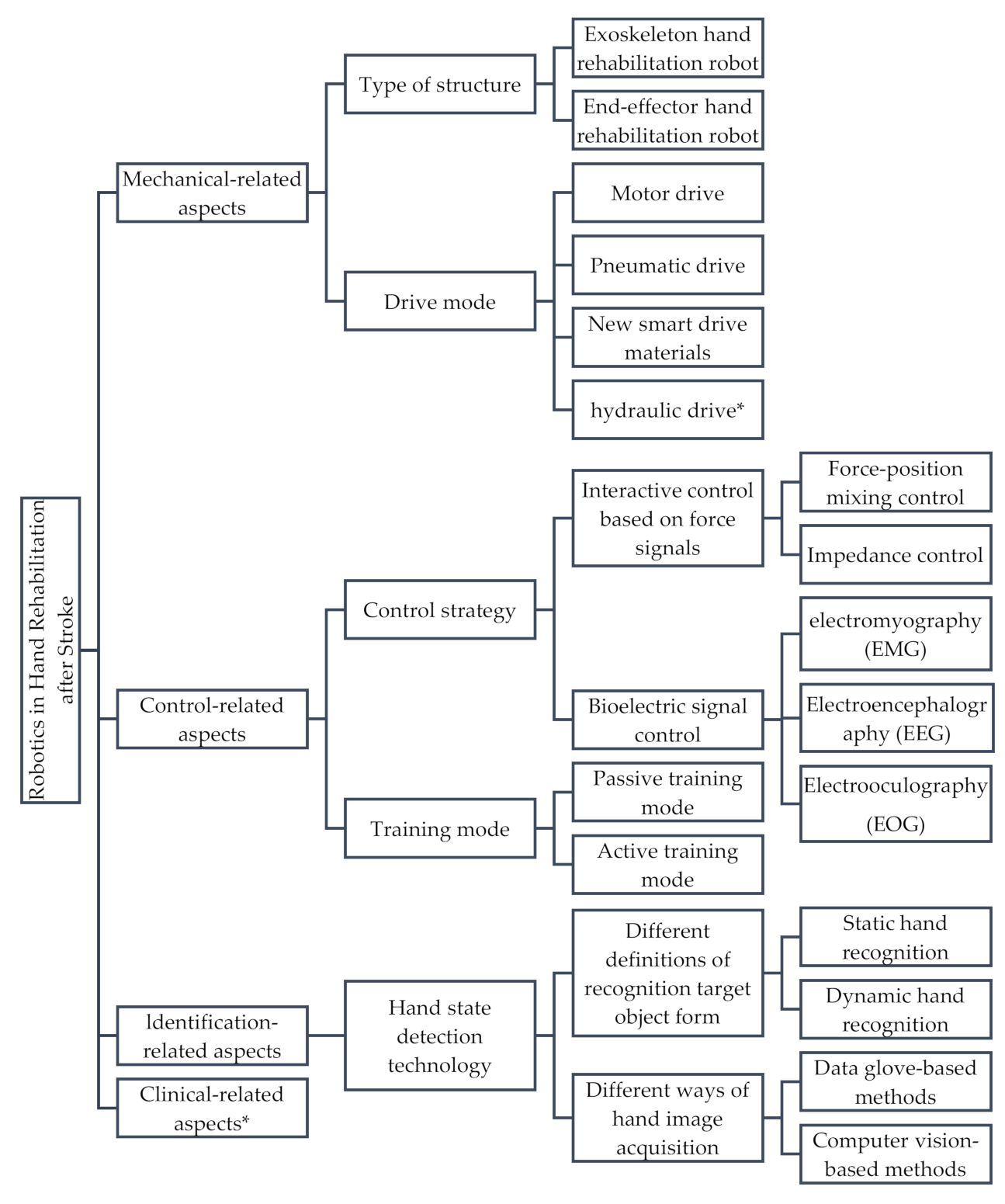
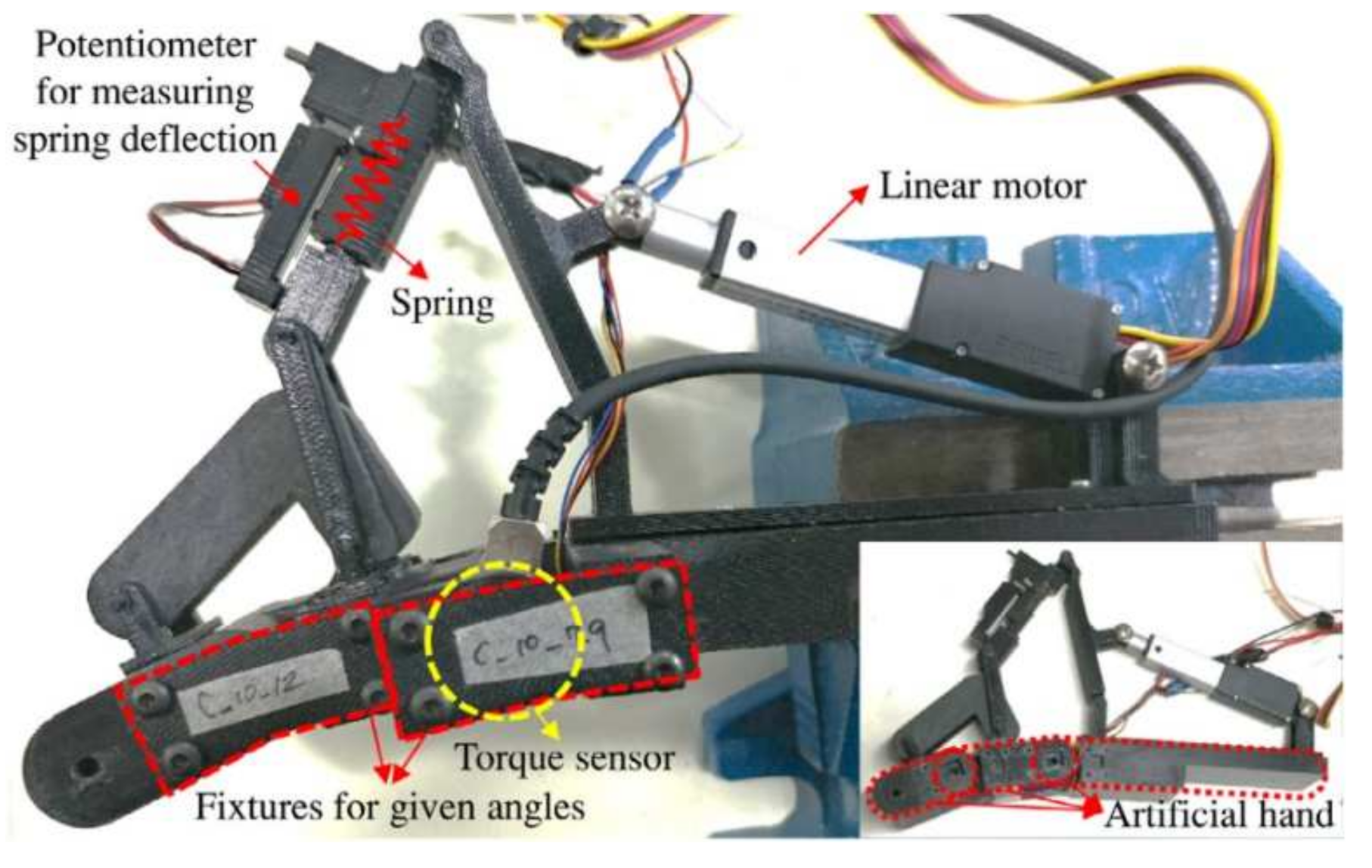
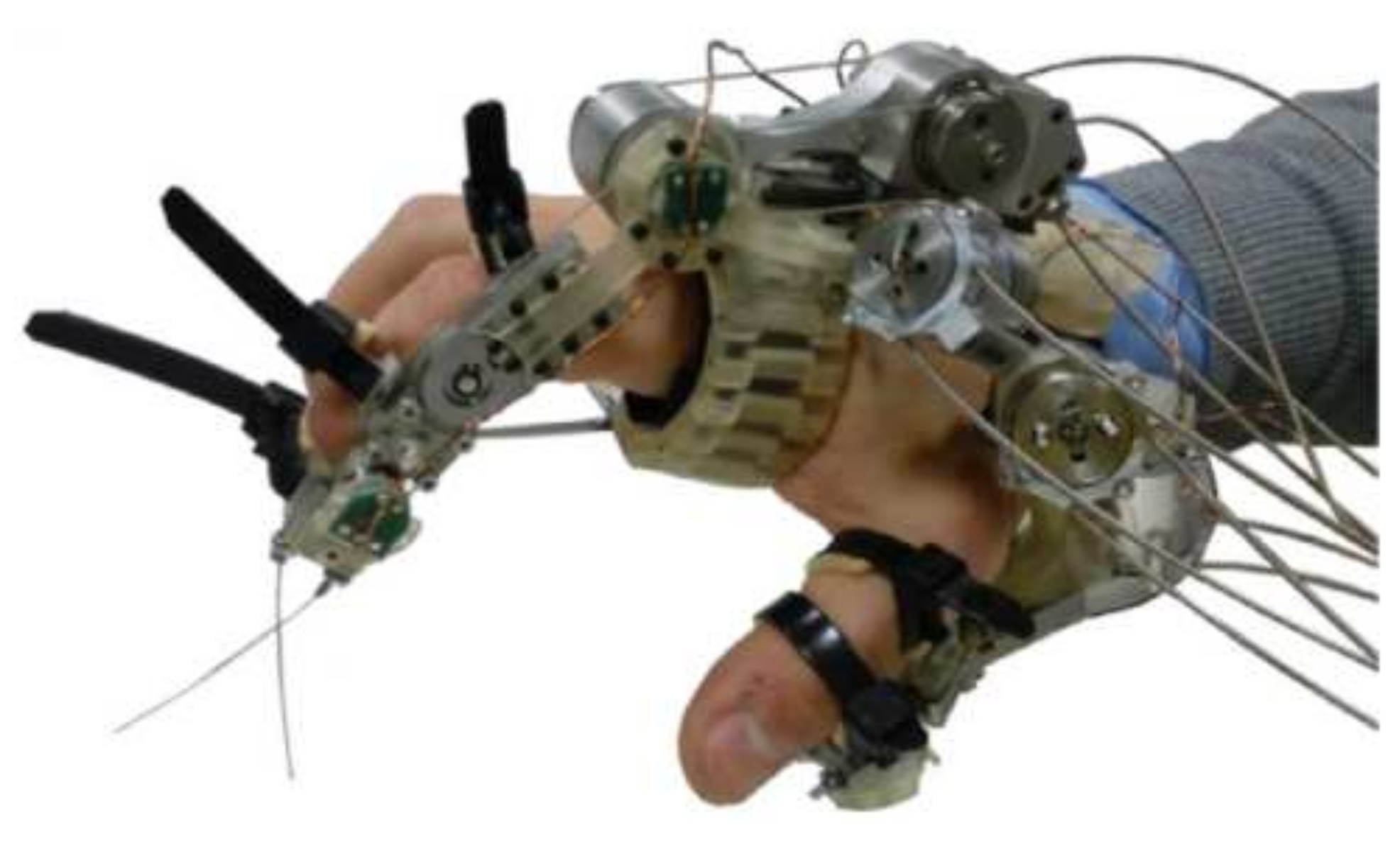
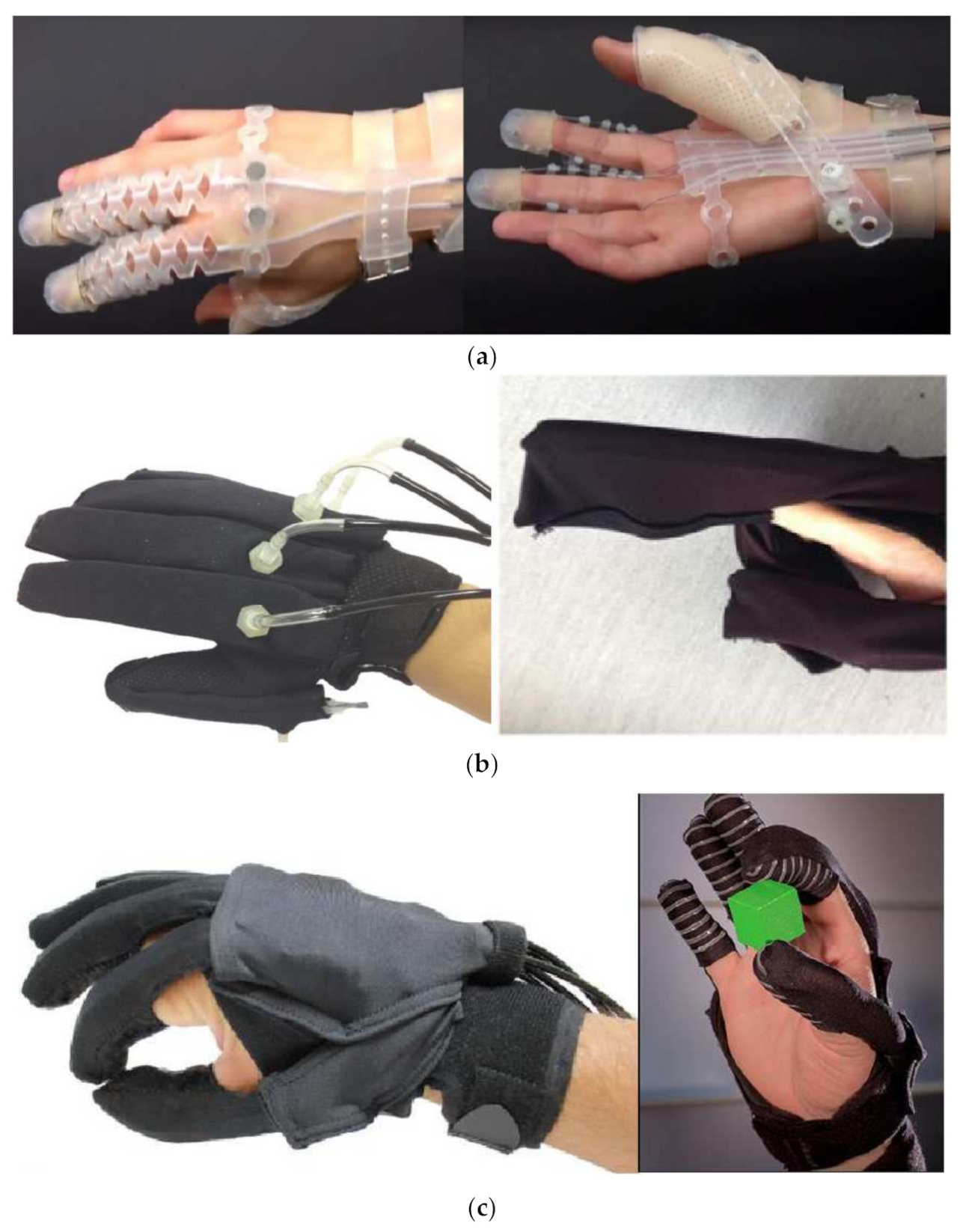

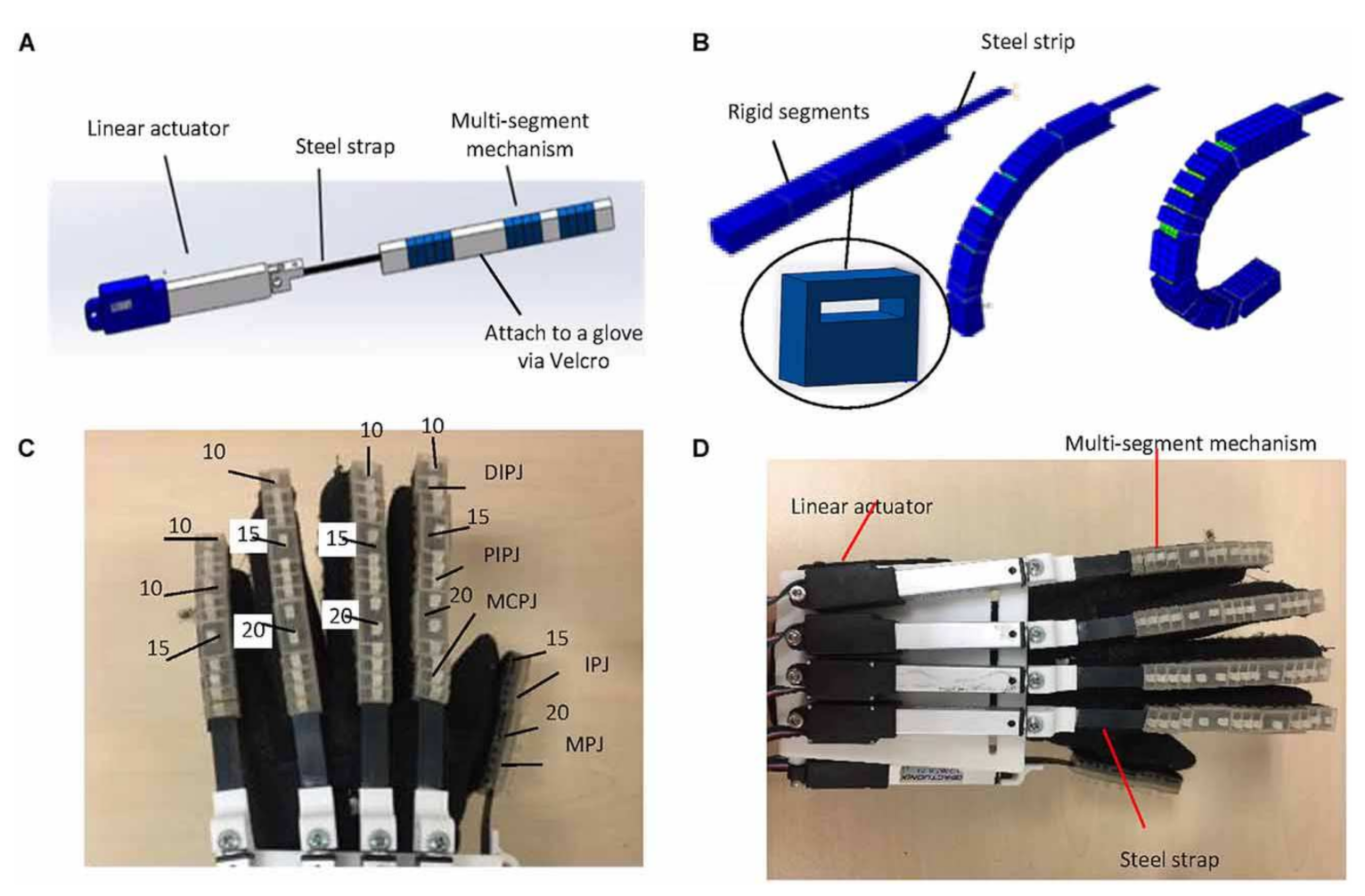
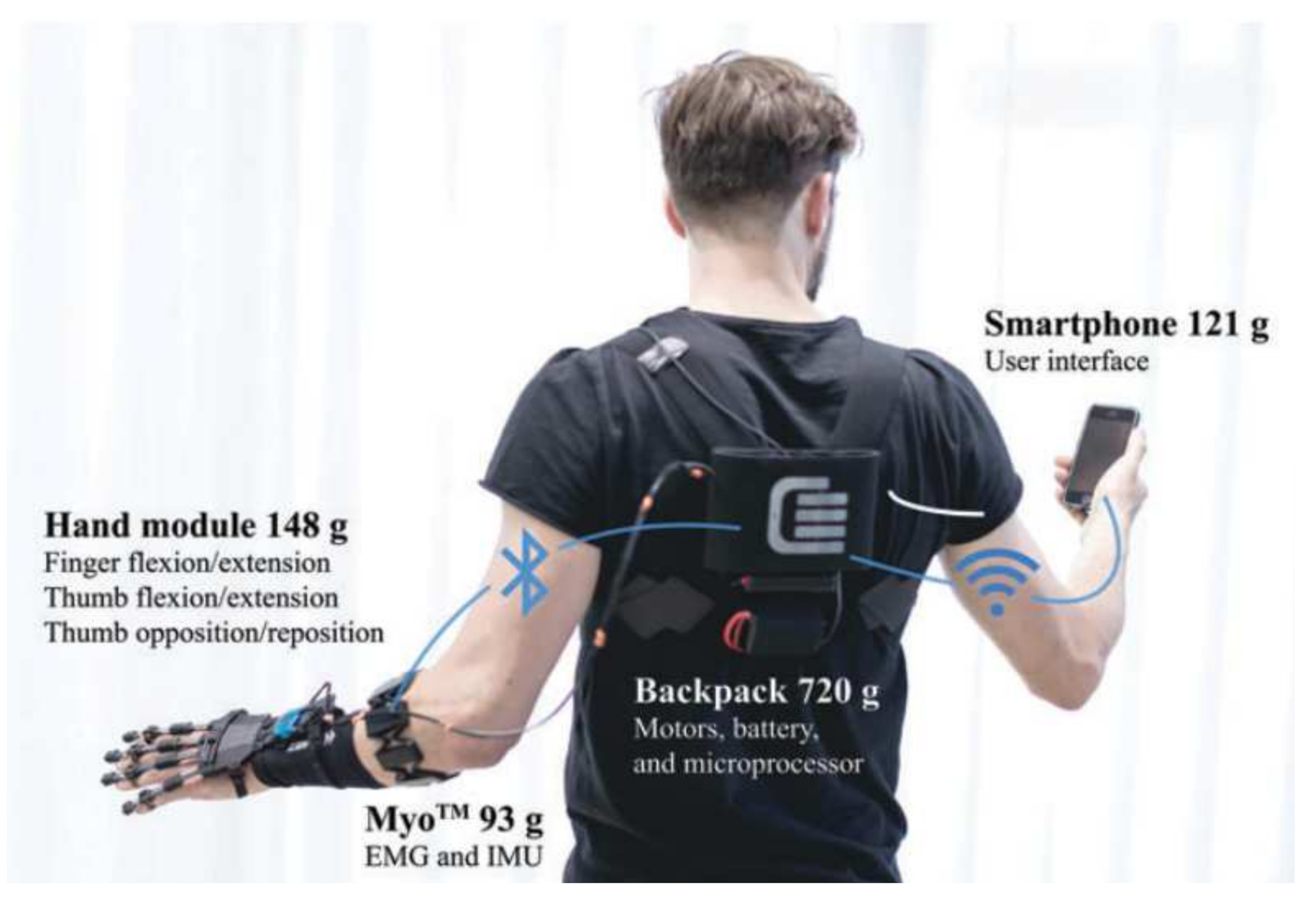
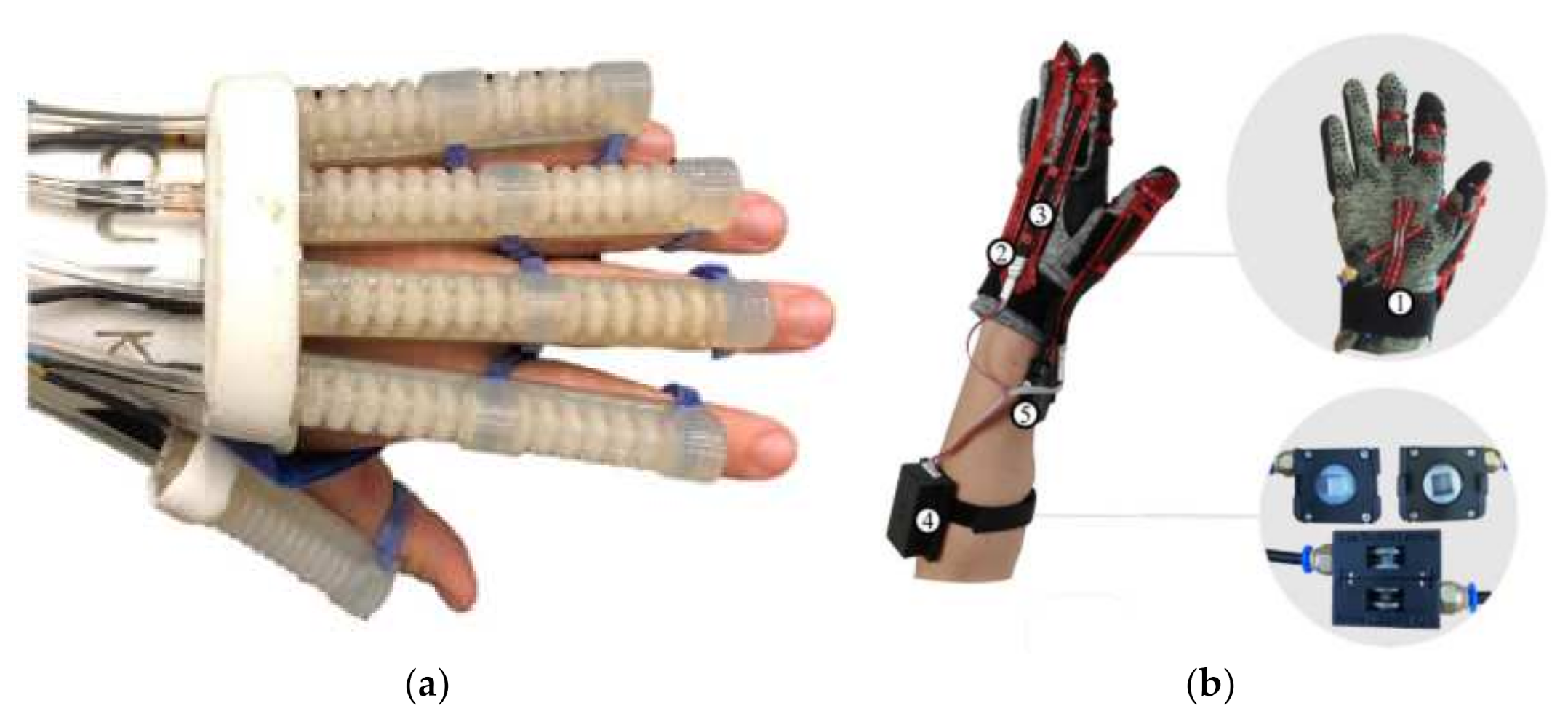



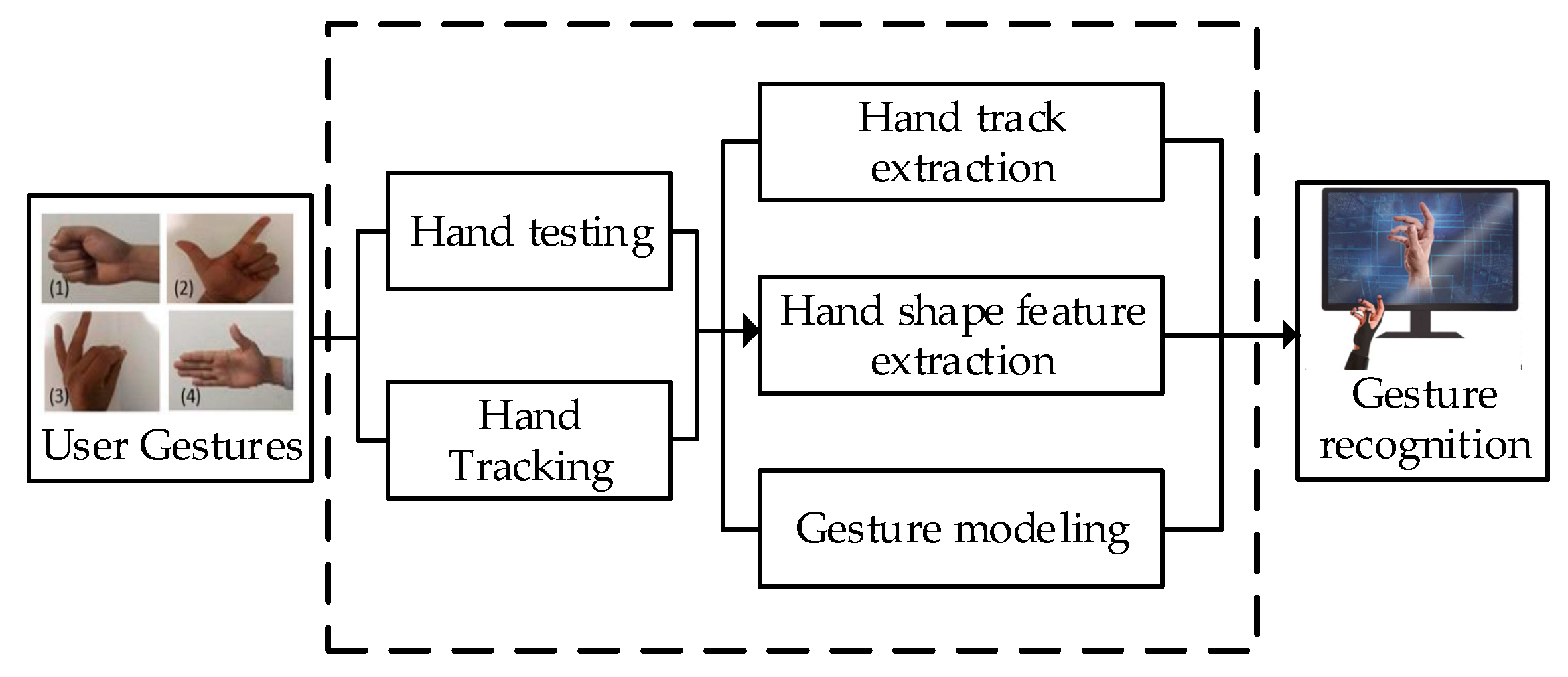
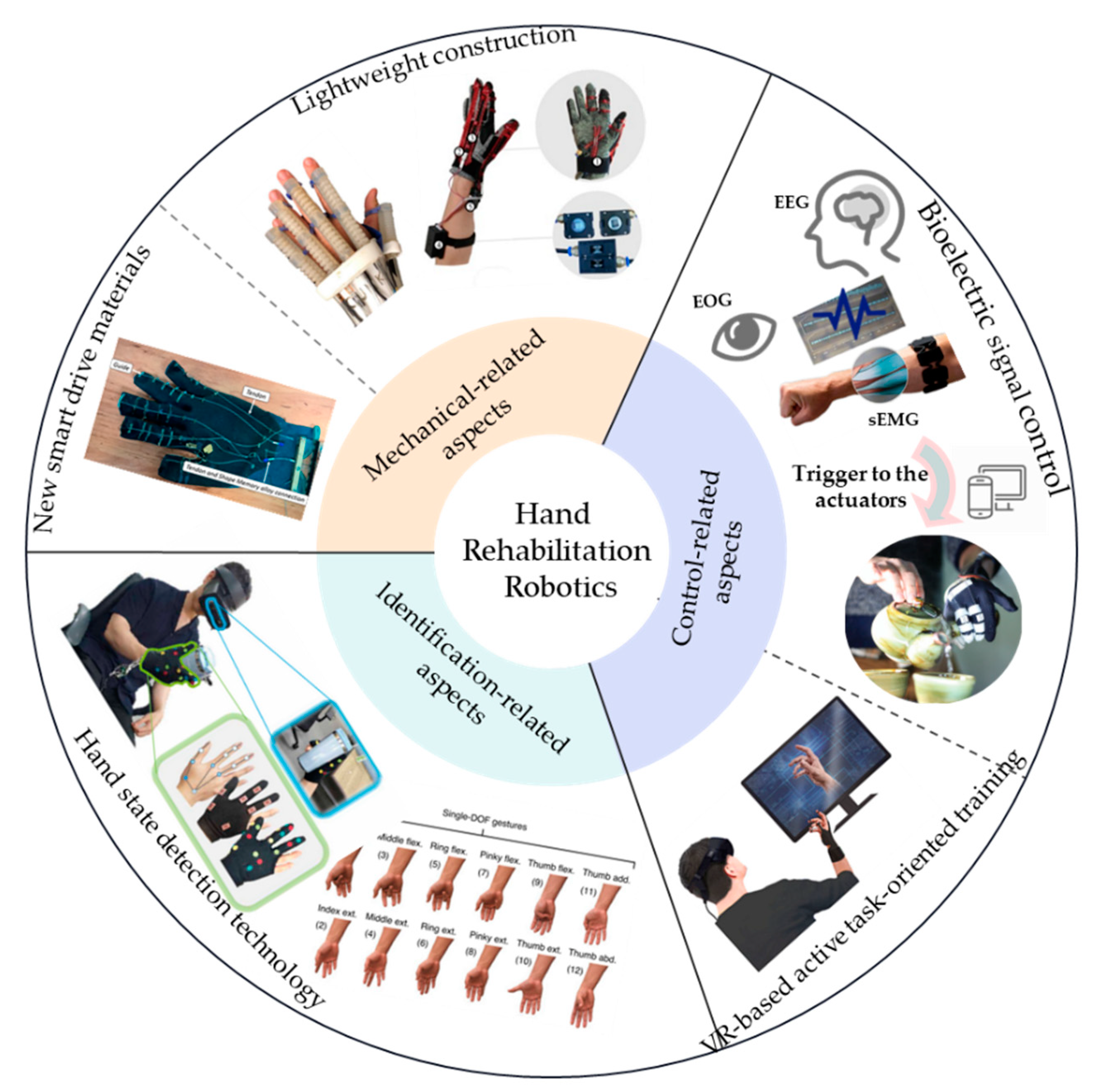
| Groups | Representative Works | Researchers | Actuated DoF | Driving Modes | Control Strategies | Force Transmission Mode |
|---|---|---|---|---|---|---|
| The exoskeleton hand rehabilitation robots | [51] | J. Iqbal et al. | 4 | Motor drive | Preset | Link |
| [52] | D. Leonardis et al. | 5 | Motor drive | Preset | Link | |
| [28,29] | R. Conti et al. | 4 | Motor drive | Preset | Rope + Connecting rod | |
| [30,31] | S. Kim et al. | 1 | Motor drive | Preset | Link | |
| [33] | Decker et al. | 5 | Motor drive | Preset | Link | |
| [34] | I. Jo et al. | 5 | Motor drive | Preset | Link | |
| [35] | Sale et al. | 4 | Motor drive | Preset | Cable + chain | |
| [36] | F. Zhang et al. | 6 | Motor drive | Preset | Cable + Link | |
| [53] | A. Lince et al. | 1 | Motor drive | EMG | Cable + Link | |
| [54] | A. Bataller et al. | 1 | Motor drive | Preset | Link | |
| [25] | I. Jo et al. | 1 | Motor drive | Preset | Spring + Link | |
| [37] | D. Marconi et al. | 5 | SEA | Force Control | Link | |
| The end-effector hand rehabilitation robots | [55] | Haghshenas-Jaryani, M. et al. | 3 | Hybrid Pneumatic | Preset | Pneumatic artificial muscle |
| [56,57] | Polygerinos, P. et al. | 5 | Hydraulic | Preset | Rubber Return Spring | |
| [58] | Diftler, M.A. et al. | 3 | Motor drive | Force Control | Tendon/Cable-pulley | |
| [59] | Fischer, H.C et al. | 5 | Motor drive | Preset | Cable | |
| [60] | H. K. Yap et al. | 5 | Pneumatic | EMG | Flexible Actuators | |
| [61] | Y. Park et al. | 3 | Motor drive | Force Control | Cable | |
| [62] | B. W. K. Ang et al. | 5 | Pneumatic | EMG | Flexible Actuators | |
| [63] | B. B. Kang et al. | 2 | Motor drive | Force feedback control | Cable | |
| [64] | D. Popov et al. | 4 | Motor drive | Preset | Tendon | |
| [65] | L. Randazzo et al. | 5 | Motor drive | EEG | Artificial tendon | |
| [66] | Thielbar, K.O. et al. | 5 | Motor drive | Active task orientation | Tendon/Cable-pulley | |
| [67] | Chua, M.C. et al. | 4 | Pneumatic | Force control | Pneumatic artificial muscle | |
| [47] | M. Li et al. | 5 | Motor drive | EEG | Multi-Segment | |
| [48] | Butzer, T. et al. | 2 | DC motors | EMG | Spring blade | |
| [68] | Qiaoling Meng et al. | 1 | Motor drive | Force control | Tendon | |
| [49] | Zhi Qiang Tang et al. | 5 | Pneumatic | EMG | Pneumatic artificial muscle | |
| [50] | Marek Sierotowicz et al. | 2 | Motor drive | EMG | Tendon |
Publisher’s Note: MDPI stays neutral with regard to jurisdictional claims in published maps and institutional affiliations. |
© 2022 by the authors. Licensee MDPI, Basel, Switzerland. This article is an open access article distributed under the terms and conditions of the Creative Commons Attribution (CC BY) license (https://creativecommons.org/licenses/by/4.0/).
Share and Cite
Liu, C.; Lu, J.; Yang, H.; Guo, K. Current State of Robotics in Hand Rehabilitation after Stroke: A Systematic Review. Appl. Sci. 2022, 12, 4540. https://doi.org/10.3390/app12094540
Liu C, Lu J, Yang H, Guo K. Current State of Robotics in Hand Rehabilitation after Stroke: A Systematic Review. Applied Sciences. 2022; 12(9):4540. https://doi.org/10.3390/app12094540
Chicago/Turabian StyleLiu, Chang, Jingxin Lu, Hongbo Yang, and Kai Guo. 2022. "Current State of Robotics in Hand Rehabilitation after Stroke: A Systematic Review" Applied Sciences 12, no. 9: 4540. https://doi.org/10.3390/app12094540
APA StyleLiu, C., Lu, J., Yang, H., & Guo, K. (2022). Current State of Robotics in Hand Rehabilitation after Stroke: A Systematic Review. Applied Sciences, 12(9), 4540. https://doi.org/10.3390/app12094540







